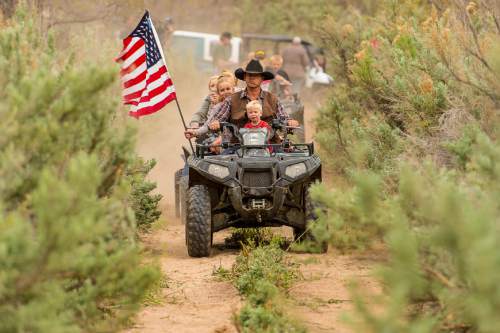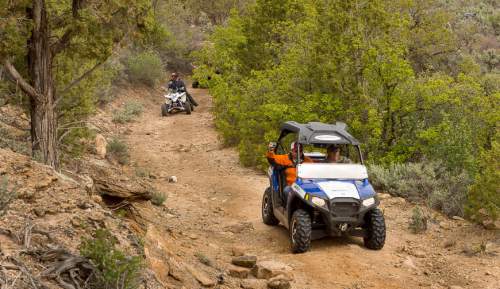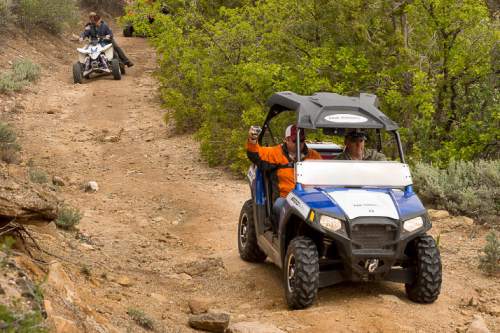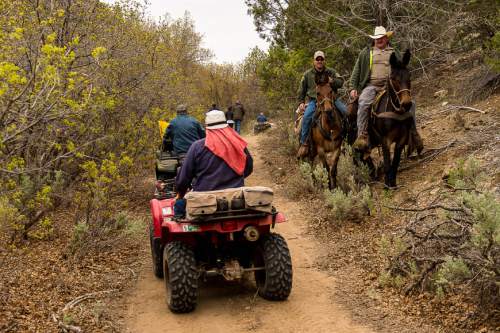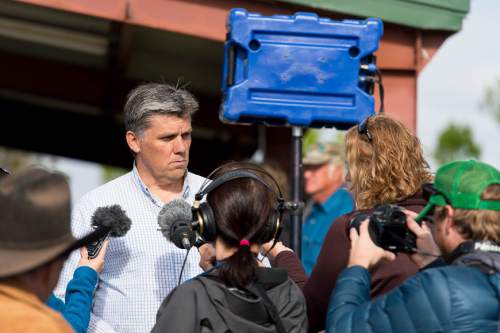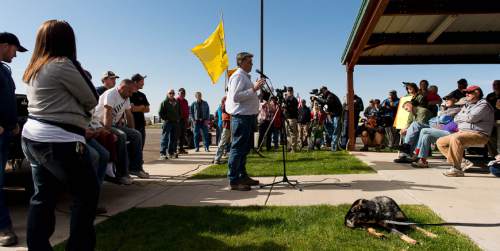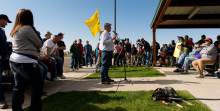This is an archived article that was published on sltrib.com in 2015, and information in the article may be outdated. It is provided only for personal research purposes and may not be reprinted.
San Juan County Commissioner Phil Lyman and three other men "crossed a line" into crime when they motored into Recapture Canyon outside Blanding last year, prosecutors argued Wednesday at the opening of the protesters' trial on conspiracy charges.
"Each of these four defendants knowingly and willfully drove an ATV through an area they knew was closed," Assistant U.S. Attorney Lake Dishman told the jury seated in Salt Lake City's U.S. District Court. "It was an act of defiance against the BLM."
When it lays out its case Thursday, the defense intends to put the Bureau of Land Management on trial, arguing federal land managers are keeping people off public lands by unnecessarily prolonging restrictions on motorized access.
Lyman maintains seven years of BLM inaction on the county's right-of-way application spurred him to organize the May 10, 2014, protest in which about 50 ATV riders toured the canyon.
Before bringing in the 12-member jury Wednesday, Judge Robert Shelby ruled on last-minute defense motions, rejecting all but one. He agreed with Lyman's lawyer that prosecutors should not draw out testimony about the firearms some of the riders carried.
But the judge rejected Lyman's request to bar prosecutors from describing the event as an "illegal ride."
Shelby noted the court has already concluded the BLM acted legally when it closed a 7-mile stretch of the 37-mile canyon.
"That is not an issue at trial," he said. "We are not having the jury decide whether the closure was lawful."
In 2007, the BLM determined motorized recreation was taking an unacceptable toll on the canyon's middens, graves, pit houses and other archaeological resources hidden on the canyon floor.
Although the ensuing closure was not intended to be permanent, the order said it would remain in effect "until the considerable adverse effects leading to the closure have been eliminated and measures have been implanted to prevent recurrences."
But after years of working in good faith with the BLM to reopen the canyon, San Juan County residents lost patience, Lyman defense attorney Jared Stubbs told jurors.
"This was a canyon they had been visiting all their lives. Year after year, the BLM would not lift the closure order," Stubbs argued. "Phil Lyman and the others believed they had a right to be in the canyon. The evidence will show that they did not violate the law."
Retired BLM state Director Juan Palma, a key prosecution witness, agreed the protesters had every right to be in the canyon — just not on motorized vehicles.
Much of Wednesday's evidence centered on establishing the fact that Lyman and co-defendants Shane Marian, Franklin Trent Holliday and Monte Wells rode into the closed part of the canyon.
In an effort to avoid confrontation, BLM law enforcement had no visible presence in the canyon that day.
Officials set up four motion-activated trail cameras and assigned a single officer to document the ride. In plain clothes, BLM state chief ranger Jason Moore positioned himself with a camera about a half mile into the closed part of the canyon and left at 11 a.m., long before the ride ended.
San Juan County Sheriff Rick Eldredge, whose deputies patrolled the canyon on horseback, directed where federal officers could go.
"The sheriff guaranteed our protection," Moore testified, "as long as we did what he said."
Accordingly, key video evidence was shot not by law enforcement but by Bluff-based conservationist Josh Ewing, whose materials prosecutors obtained under subpoena. Unlike BLM rangers, he spent the whole day in the canyon and roamed from Recapture Dam 7 miles south to where the closed area ends at Perkins Road.
Ewing set up his video camera at the end of the so-called Pipeline Road, where Lyman turned around and had encouraged others to do the same.
"That was an important point," said Ewing, executive director of the Friends of Cedar Mesa. "Folks who continued past that point would do damage. I was hopeful people would not go past. Many people did."
After the riders drove by, Ewing followed on foot, photographing the impact the ATVs left on the canyon floor as they followed the overgrown trail that led to the closure back in 2007.
The illegal trek grew out of an agreement the four defendants had to violate the law and to invite others to participate, Dishman told the jury.
"It was not a conspiracy shrouded in secrecy," he said.
The scheme started at a town-hall meeting Lyman hosted 2½ months before the ride, Dishman added, and developed on Lyman's Facebook page and in Wells' blog, The Petroglyph.
The trial is expected to conclude this week. If convicted, the men face up to one year in jail and $100,000 in fines.



